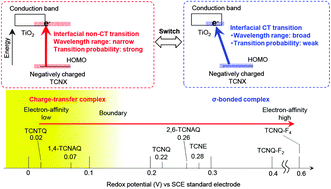Charge-transfer complex versus σ-complex formed between TiO2 and bis(dicyanomethylene) electron acceptors†
Abstract
A novel group of organic–inorganic hybrid materials is created by the combination of titanium dioxide (TiO2) nanoparticles with bis(dicyanomethylene) (TCNX) electron acceptors. The TiO2–TCNX complex is produced by the nucleophilic addition reaction between a hydroxy group on the TiO2 surface and TCNX, with the formation of a σ-bond between them. The nucleophilic addition reaction generates a negatively-charged diamagnetic TCNX adsorbate that serves as an electron donor. The σ-bonded complex characteristically shows visible-light absorption due to interfacial charge-transfer (ICT) transitions. In this paper, we report on another kind of complex formation between TiO2 and TCNX. We have systematically studied the structures and visible-light absorption properties of the TiO2–TCNX complexes, with changing the electron affinity of TCNX. We found that TCNX acceptors with lower electron affinities form charge-transfer complexes with TiO2 without the σ-bond formation. The charge-transfer complexes show strong visible-light absorption due to interfacial electronic transitions with little charge-transfer nature, which are different from the ICT transitions in the σ-bond complexes. The charge-transfer complexes induce efficient light-to-current conversions due to the interfacial electronic transitions, revealing the high potential for applications to light–energy conversions. Furthermore, we demonstrate that the formation of the two kinds of complexes is selectively controlled by the electron affinity of TCNX.


 Please wait while we load your content...
Please wait while we load your content...